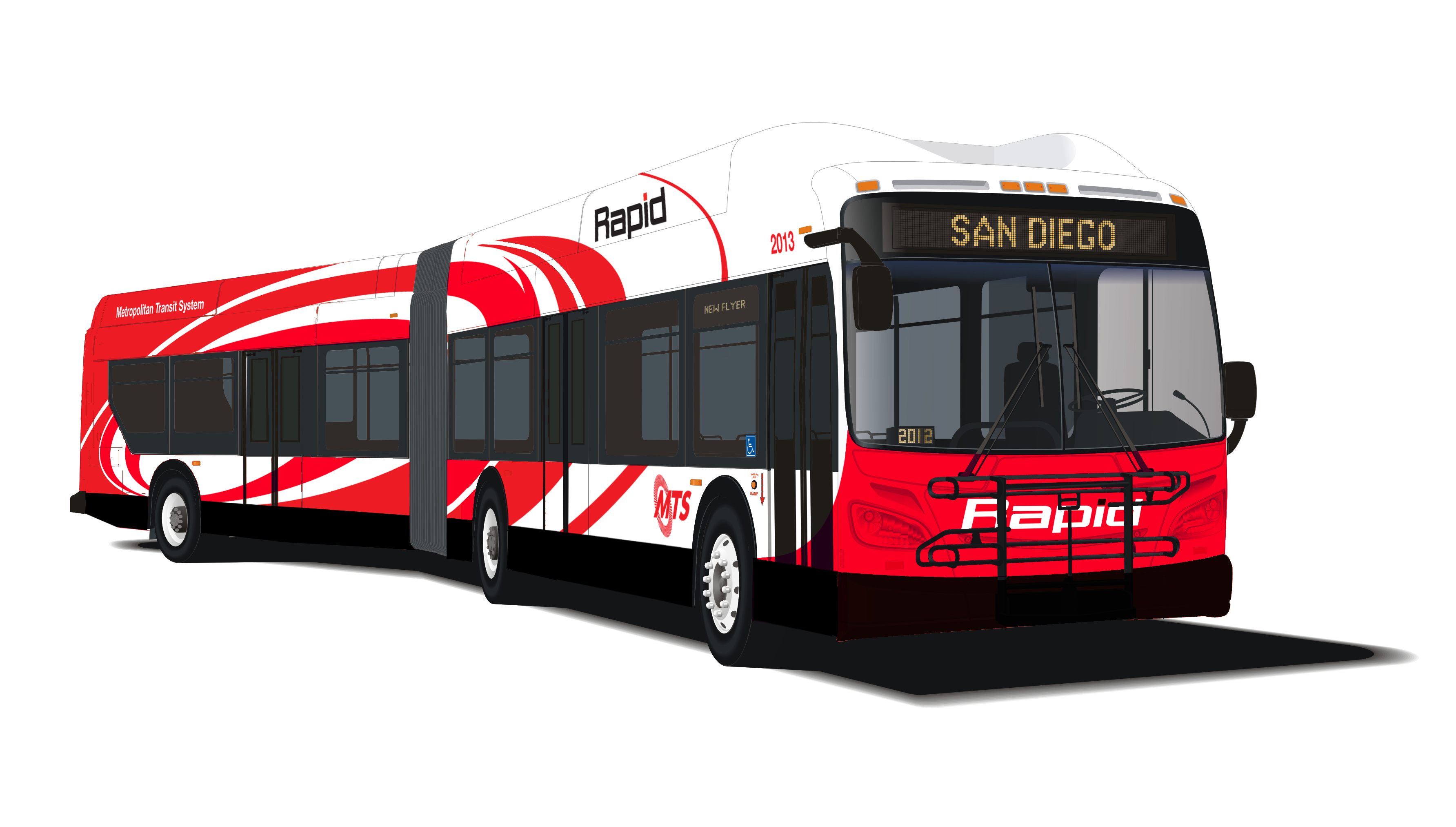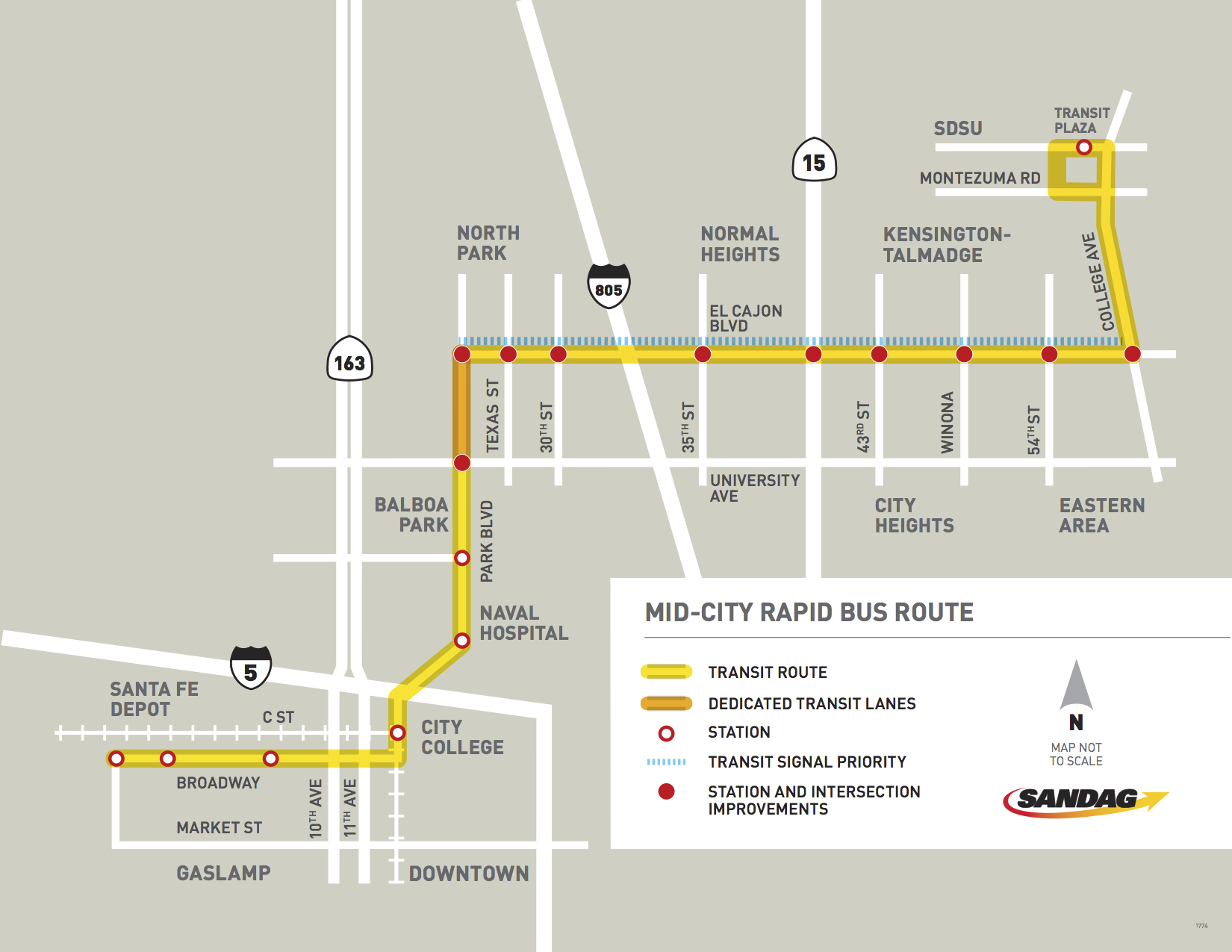By the end of the year, San Diegans will have a new way to get around the city without driving.
The Mid-City Rapid will be the first of a new type of public transit line that’ll figure heavily in the future of public transportation in the region.
The idea is that it’s cheaper than a rail line and better than a bus line. It’s a super bus. Or a diet trolley. In planning jargon, it’s called “bus rapid transit.” San Diego is branding the four coming lines The Rapid.
Not everyone loves the idea. Environmentalists and some transit advocates, for instance, think of it as faux-transit: By refusing to invest in a legitimate rail system, planners have cemented their commitment to a car-based transportation network.
Here’s a primer on the concept, and what to expect out of the Mid-City line.
What is it?
It’s a bus. It’ll run on city streets. It’ll pick up and drop off passengers at set stations.
But it’ll have large, well-lit, covered stations with big signs that’ll tell you when the next bus will arrive. And those are the only stops it’ll make (unlike a local bus, which stops every couple blocks, whenever someone is at a stop or pulls the chord).
That’s one of the major advantages planners see. The comfort and reliability are expected to encourage more people to use the service, and to give those who already use it a better experience.
Here’s how Atlantic Cities explained the concept. They argue more cities should look to bus rapid transit to solve transportation problems:
Bus-Rapid Transit lines, or BRT, are designed to address a flaw in most public bus systems: they’re slowed down by the automobile traffic that surrounds them. Stuck in lanes shared with cars, caught up at frequent traffic lights, and often stopping every block, buses too often fail to attract riders who have an alternative. Slow speeds, infrequent arrival, and a generally low service level too often make buses less appealing than rail.
“The whole aim of the rapid is to create a trolley on tires,” said David Schumacher, principal planner at the San Diego Association of Governments, or SANDAG, a sort of United Nations of cities in San Diego County that plans and implements major transportation projects.
So it’s faster, then?
Yeah, but not by a lot.
Traveling from San Diego State University to downtown — or vice versa — takes around 40 minutes right now on the 15 bus, though that can vary depending on date, time, traffic and the direction you’re traveling.
The new service will cut that by about 20 percent, Schumacher said.
It’s not a perfect apples-to-apples comparison — the 15 bus goes on the freeway for a bit, while the rapid will stay on main roads like El Cajon Boulevard and Park Boulevard, allowing it to provide better service to destinations in City Heights, North Park and Hillcrest. And those numbers can differ based on day and time.
One reason it’s faster than a normal bus is because it has fewer stations that are farther apart, so the bus can get faster, quicker – and stop less often.
It also gives the drivers a tech solution that’ll let them change a traffic light to green if they’re falling behind schedule because of traffic.
“In terms of travel time, it depends where you are on the corridor, but end to end we think it’ll be 20 to 25 percent faster, based on the signal priority technology,” Schumacher said. “Admittedly, this is a new service so we don’t know for sure. We don’t have rapids yet. This is our first venture.”
What are the stations like?
One major thing that planners say will set the rapid apart is its big, comfortable stations. Rather than just a bench or a pole, they’ll have canopies and signs (but not bathrooms).
They’ll also have larger sidewalk areas that’ll bulb into the street, to improve pedestrian access.
What they’re missing, said Randy Van Vleck, active transportation manager at the City Heights Community Development Corporation, is a sense that they’re public spaces that reflect the neighborhoods they’re in.
He wishes planners had put more time into installing public art, or creating more inviting seating areas with landscaping. That sort of investment, and reaching out to the public for their input, helps make local residents like the project more, and less likely to oppose it for other reasons.
“I think it’s a sense of place that they want,” Van Vleck said.
The city secured some funding to plan for pedestrian improvements along the line, in the Little Saigon area on El Cajon Boulevard.
When does it start?
The Mid-City line has been under construction since July, and is scheduled to open on Aug. 31.
The project cost $44 million, including buying the new vehicles, and half of the money came from the county’s half-cent sales tax to pay for transportation projects, TransNet. The other half was federal money.
“So we are only dealing with $10 million in infrastructure development,” said Jack Shu, of the Cleveland National Forest Foundation, which opposes SANDAG’s long-term transportation plan because it believes it invests too much in freeway widening (projects that encourage car use), and not enough on transit (projects that allow less car use). “In the big picture of multibillion-dollar projects, it’s almost nothing.”
Mid-City is one of three rapid lines that’ll open this summer.
The I-15 Rapid, which runs from Escondido to downtown along the I-15 corridor, will open in June, and will connect with the Mid-City line at a couple stops. SANDAG widened the I-15, adding lanes for busses and carpools, to make way for the service. The stations will be on special off-ramps from those lanes, so the busses can pull off, pick up passengers and get back on the freeway without hassling with local traffic.
There’ll be another line that connects Rancho Bernardo to Sorrento Valley, but that’ll mostly run during peak commute times. It’ll share some stops with the I-15 service, with the hope of connecting the whole rapid system to the job center in the UTC and Golden Triangle area.
In late 2016, the last planned rapid line will open, from the Otay Mesa border crossing through South Bay to downtown.
What’s the problem?
One problem environmentalists, like the Cleveland National Forest Foundation, have with the new line is its reliance on expanding freeways.
The Mid-City line doesn’t do that, but it’s also not light rail. SANDAG’s long-term plan calls for eventually converting it into a trolley line, but Shu said the project is too small to make a real difference.
“Personally, I think the project is OK,” he said. “But it’s just far short of what is needed and we should not consider it anything close to an acceptable level of progress. If we just do a few projects like this every few years, we will continue to fall further behind in having a working transit system since we are spending much more on freeways, parking and other auto-centric travel.”
He’s also not all that interested in talking about individual transit lines.
“It’s important that we address the whole system rather than one line at a time,” he said. “In this regard, we should be working to establishing a functional network rather than just a point A to B and points in between approach.”
Elyse Lowe, deputy executive director of transit advocacy group Circulate San Diego, said it isn’t fair to tell people who live in the area that they have to wait even longer for a trolley.
“I don’t buy that it’s better for low-income people having a tough time making ends meet, not giving them a great transit option, or telling them that they have to wait for rail,” she said.
What’s missing?
A lot of the Mid-City neighborhoods the line goes through are some of the city’s most walkable. That’s a result of how the area’s developed, and how it’s been planned over the years.
But the city missed an opportunity to plan for the types of development right around the new stations that would really benefit from improved transit service.
That sort of thing — large apartment complexes where residents wouldn’t necessarily need cars anymore, offices where people could take the new bus to work — helps get the most out of the $44 million investment. Because it’s more useful, ridership increases. Because people choose to use it, they can consider driving less, or not at all, and have more money for other needs.
Civic San Diego, a nonprofit group that does some planning for the downtown area, is pushing to draw up plans like that near the new stations in City Heights. The city of San Diego could also choose to do that without Civic San Diego.
But Lowe said it would be better if those projects were already in place when the project opened.
“It’s not too late, but it would have been better to have those plans in place, as opposed to doing them now,” she said.


